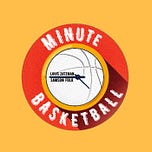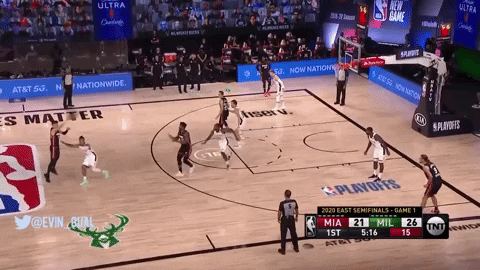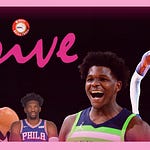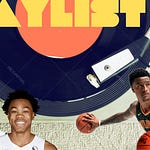It’s a subtle secret that most of basketball happens from the waist down. Your legs offer power for your jumpshot, of course, but it goes much deeper than that. It seems counter-intuitive to say, but dribbling doesn’t actually take you anywhere. Your hands and the ball are just catalysts to movement; they help you get where you’re going, either by craft or guile, but they aren’t part of the equation.
Your feet actually control movement. They’re the pivots on which the lever of basketball rests. Not only during a live dribble, but also before and after. That footwork, those pivots, are a constant differentiator between stars and the role players.
Pivoting doesn’t just describe movement on the basketball court. It also is one of the biggest differentiators between successful and unsuccessful NBA franchises off the court. Anyone can succeed when the first option comes through. When the Miami Heat or the Los Angeles Lakers signed LeBron James, their successes were almost preordained. But how do teams respond when plans change? After losing James, the Cleveland Cavaliers cratered -- until they signed him again -- and then fell apart a second time until, well, to be determined. After the Heat lost James, they were in the second round of the playoffs within two years and the Finals within five.
That ability to pivot between options defines success on and off the basketball court. This week in Minute Basketball: pivots.
Folk
Put it in Reverse
As Louis highlighted at the top, a pivot on a basketball court is a means of conveyance. But, it’s also a tether to a location. So, the way that pivots are used would seem to be extremely limited - only they aren’t. The intention with which you pivot can completely change the function of it’s utility.
Players reverse pivot many times in a game, but that doesn’t stop it from being one of my favourite things to watch on a basketball court. For screen-setters, they’re carving out space and playing the role of obstacle. For scorers in the post or elsewhere it’s the precursor to an intimidating triple-threat possession. The slow swing backwards to see the court unveiled in front of you, while maintaining the momentum that feeds Jimmy Butler’s gorgeous stutter-rip (term coined by PD Web) or Kevin Durant’s famed (and now illegal) sweep through.
And that’s the appeal and the allure of the pivot. Everyone knows that something comes after, that the pivot itself isn’t dangerous, but instead each point of motion in the pivot provides a possibility of something you would have to defend against - and that thing is the danger. The pivot is the connective tissue between possibility and action, and those who do it well are introduced to more possibilities, and well, a more versatile range of actions.
And what would anything in basketball be without a little grift? The reverse pivot as a means to get away with obvious moving screens is a big-brained move by anyone who can consistently get away with it. Some bigs who do it really well are: Domantas Sabonis, Bam Adebayo, and Larry Nance Jr.. All 3 are mobile and have tremendous feel on the court. Nance Jr. gives the full range of how to completely decimate a player giving chase to one of your guards, and then get your primary defender to commit - it’s masterful, and it incorporates the very slick reverse pivot screen.
More than anything though, I love the reverse pivot because it seems like a point of rest before the dance of 1-on-1 defense can begin. Oftentimes it brings attacker and defender face to face. A quiet moment of collection before two of the world’s best attempt to best each other in a confined space.
The perceived tether
If I saw a dead ball handoff in a game, I’d still probably have it in my notes as a DHO. And what makes certain big men so dangerous when they run a DHO is that they are not beholden by anyone or anything to connect with their oncoming teammate. Some big men can extend their dribble and turn it downhill, and when they do they usually find success because most teams aren’t expecting that outcome from the action.
As you saw above with Larry Nance Jr.’s reverse pivots/screens, it’s no wonder teams view the player orchestrating the hand off as an obstacle that wants to hand off to a creator. It’s this perception of DHO’s as rote actions that has doomed certain teams down the stretch. I first saw the slipped hand off when Jonas Valanciunas hit a miraculous game-tying buzzer beating dunk against the Bucks. It happened again a couple nights ago with a clever SLOB and the Inspector Gadget-adjace, Mikal Bridges.
The perception of the pivot as a tether in these moments, allows the player on-ball to explode into the back end of a relaxed defense. Devilishly clever in its simplicity. Goes to show how often the inversion of something escapes the imagination of those who are trying to defend against it.
Zatzman
The Toronto Raptors and Giannis Antetokounmpo
We all make plans. Some of us, even ambitious plans. The Toronto Raptors put together one of the most ambitious plans imaginable. They are connected to Antetokounmpo before most NBA teams, with Masai Ujiri even helping his family emigrate to Greece. Though in his first draft with the Raptors in 2013 Ujiri doesn’t have any first-round draft picks because of his predecessor, he tries desperately to trade for the 12th pick, then the 14th one, but is rebuffed both times. Antetokounmpo is taken 15th by the Milwaukee Bucks.
So the Raptors wait. They wait eight years, watching Antetokounmpo become a superstar, watching his body become that of a god, watching his Bucks become perennial title contenders as Antetokounmpo ascends to MVP, then MVP and DPoY at the same time. The Raptors pivot to free agency in 2021, when Antetokounmpo is set to be unrestricted. They clear their books, freeing up a max slot, with the ability to clear a second one if they get really lucky and need the space for a second star. Nearly every contract they sign in the years before 2021 ends that summer; nothing can change their plans. They win a title in the waiting period, but all roads still lead to Antetokounmpo.
Then on December 15, 2020 he re-signs in Milwaukee.
What are the Raptors supposed to do? Well, maybe their money can be spent elsewhere. Rudy Gobert is going to be a free agent. Kawhi Leonard, too. There are other stars that can be available; open cap space can be spent on anyone, even though the Raptors have been planning for Antetokounmpo for almost a decade. But Gobert re-signs in Utah, and Leonard is not going to leave California after abandoning the Raptors to go home in the first place.
So Toronto is left holding a bagful of cash with no external candidates on which to spend it. Since December, they’ve pivoted in important ways. They’ve re-upped their own guys in Fred VanVleet, OG Anunoby, and Pascal Siakam, although to be fair some of those contracts came beforehand. But the plan was for them to be integral elements of the future regardless. The goal was for those three to be a supporting cast for the next championship, but now they’re the leads. And the Raptors haven’t found a supporting cast for them -- with the team 18-30, it’s been a lack of depth that has been Toronto’s downfall, as much as anything else.
Toronto could well use its hoard to re-sign Kyle Lowry this upcoming offseason, who is 35 years old, but the team has him on the roster now and is still well below .500.
It seems there’s no clear plan B. Most likely, Toronto spreads the available cap space across a few different players, trying to buy depth out of free agency. Maybe they could land a useful center in Daniel Theis, Mo Wagner, or Richaun Holmes, retain Gary Trent, and perhaps add someone who can score at the rim. That would make them a solid team, if not equal to the heights they might have attained with Antetokounmpo. They’ll always have the option of trying to build from the middle, as they did when they traded DeMar DeRozan for Leonard. Heck, maybe they can actually bring DeMar home. He would be a hugely beneficial player on and off the court. Meanwhile, this year is the year spent bottoming out -- it seems to be breaking the players’ souls, but maybe they add Cade Cunningham or Evan Mobley to the mix in the draft, which would completely change the future outlook of the franchise.
That bottoming out theory is probably what Ujiri has chosen. He still has not found a serviceable center, and the team has two open roster spots despite having multiple players in health and safety protocols and others out with injury. Adding Antetokounmpo in free agency was Toronto’s first choice for adding talent, but the draft is the best option remaining.
But regardless, even if Ujiri is trying to lose games on purpose for a high draft pick, that was only a recent decision. It is starting to look as if Toronto’s plan B is the same as their plan A, but without Antetokounmpo on board. That’s akin to picking up your dribble without the option to pivot after.
The Oklahoma City Thunder and the curse of James Harden
It’s like the start of a joke: how many MVPs does it take to win a championship in Oklahoma City? Apparently, more than three. Kevin Durant, James Harden, and Russell Westbrook were once together, and all three have passed like rain on the mountain, like wind in the meadow.
In 2012, Sam Presti -- more like Clay Bennett -- decided the team was too expensive to keep together and pivoted by trading Harden to the Houston Rockets for Kevin Martin, Jeremy Lamb, and picks rather than extending the star’s contract. Call it the curse of the Beardbino.
Then the Thunder spent a few years close but not close enough, lost Durant, and replaced him with Paul George. Then they weren’t close at all, and apparently three straight years of losing in the first round of the playoffs scarred Presti to such an extent that he pivoted straight to Moneyball 2: the search for less payroll.
Now the Thunder exist in a perpetual state of a Piet Mondrian painting: awash in colour and shape and potential, but with nary a foundation in sight. Take on picks for the burden of acquiring Chris Paul, let him run the team, and then trade him elsewhere for even more picks. Do the same with Al Horford. The only commonality, Oklahoma’s only currency, is draft picks. It’s like a game of Pacman, with a higher and higher score being the ultimate goal rather than an actual possibility of winning the game. They play extremely raw players real minutes and then sign them for pennies on the dollar, signing players like Moses Brown or Lu Dort to team friendly deals before they can improve too much, which is another way of saying, robbing them of their fair value.
Where does the tailspin stop? When do 17 first-round draft picks become an actual NBA team, one with only 15 permanent roster spots?
The Thunder’s pivot to villain and vaudevillian Sam Hinkie disciple is an unexpected one, at the very least. Plan A was winning a championship or five with Kevin Durant, and plan B was stealing a spite title with Russell Westbrook. They’ve now pivoted to plan C, which is running the franchise like Out Of The Park Basketball, and simming for a decade or so before all the rookies hit the legal drinking age. We all make choices.
Oh, and the Thunder and Raptors played each other on Wednesday night. It was, as you can might have expected, a sloppy affair. The Thunder won, proving that no matter how hard you try to lose, you can still screw that up, too.



















Share this post